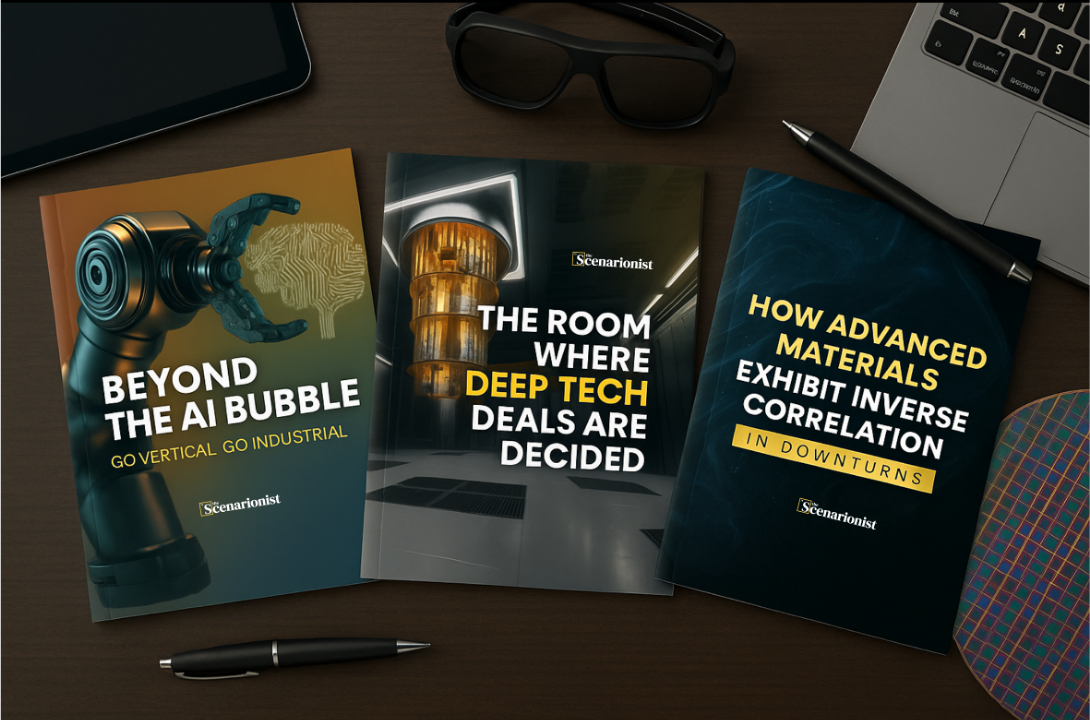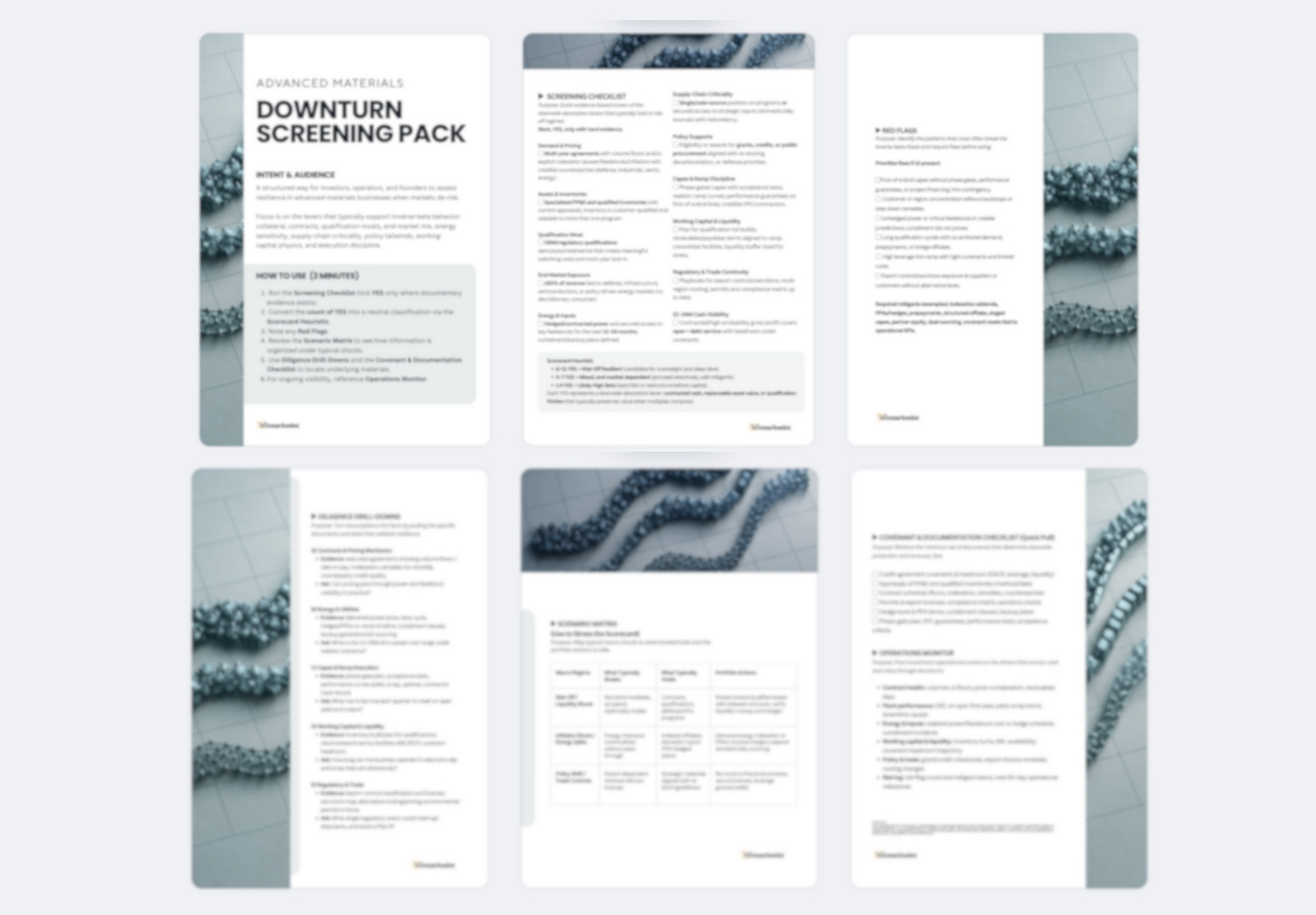Deep Tech Monthly in Review - September 2025
Field Notes from The Scenarionist. A Strategic Recap for Builders and Backers.
Dear Builders and Backers,
September didn’t chase novelty — it priced reliability. Across power, compute, and materials, the market rewarded assets that turn physics into contracted cash and penalized anything that failed to pass safety certification, secure grid connections, or integrate on schedule.
Energy made the clearest pivot. Fusion moved off slides and into supply chains: ITER’s superconducting fusion magnet — the central solenoid for the International Thermonuclear Experimental Reactor — shipped, high-temperature superconductor programs progressed, and private rounds formed behind equipment that will live inside real projects with future purchase commitments. The message is bankability.
As milestones line up with construction calendars and grid hookups, fusion begins to look like pre-infrastructure: warranty curves, availability guarantees, and copy-exact procedures become the terms that release capital. Other sources of always-on power followed the same pattern. Geothermal advanced by borrowing oilfield playbooks, standardizing drilling and completion, and treating the first commercial unit as a repeatable qualification program rather than a one-off experiment. The practical move: secure your place in the queue (grid capacity, permits, specialized components), pre-negotiate purchase agreements, and price uptime like a product.
Compute shifted to the physical layer. The first meaningful exit in silicon photonics during the generative-AI cycle wasn’t just a headline; it signaled that value is accumulating where bandwidth and heat are controlled. Boards financed topology, not talk — optics migrated closer to accelerators, power delivery was integrated on the board, and liquid-cooling approaches were priced against energy per unit of data moved and ease of service. Inside the rack, performance is now layout under heat. Procurement followed suit: multi-year capacity reservations, thermal limits written into contracts, and service commitments that monetize uptime. Founders who co-design input/output, power, and cooling around these constraints will win structured commitments and a better cost of capital.
Materials provided the risk hedge. Companies with operating plants, documented quality approvals, and long-term contracts softened drawdowns compared with “lab-only” stories. That matters because qualification data, certification timelines, and warranty economics stopped being back-office paperwork; they became pricing power. The investable pattern is consistent: lock feedstock and utilities, reserve testing and certification slots early, standardize modules that lenders can model, and ramp capacity only against enforceable purchase agreements. In that regime, margins look more like infrastructure than optional bets.
Chemistry met cash flow the hard way. Sodium-ion batteries stalled between purchase orders and a safety stamp, exposing the working-capital gap that kills hardware when certification drifts. With lithium prices reset from their peak, sodium-ion must win on total cost in use and duty cycle, not a tidy cost-per-kilowatt-hour slide. The operating answer is structural finance: debt that unlocks at certification milestones, revolving credit against contracted backlog, insurance that covers first-article and warranty risk, and explicit buffers for test-lab delays. Teams that wire those gates move forward; teams that don’t, don’t scale.
Defense technology entered specification reality. Buyers paid for systems that survive contested conditions: tight latency budgets, tolerance to electromagnetic interference, resilient communications, and clean, auditable authorization to run on secure networks. The dual-use edge is real when civilian deployments generate reliability data that shortens military accreditation. Design choices follow: hardware that can be serviced in the field, continuity of spare parts, and logging that satisfies both safety regulators and mission assurance. The commercial result is durable, multi-year support revenue, not one-off pilots.
Food technology got operational. Cost parity is now the baseline; performance and compliance unlock the premium. Winning roadmaps were legible: pilot yields verified, food-safety and good-manufacturing systems implemented, shelf-life and sensory variance budgeted, and tightly specified purchase agreements linked to production windows and cold-chain capacity. That clarity opens non-dilutive options — equipment finance, inventory lines, and supplier credit — which compress dilution and accelerate deployment.
Sovereign infrastructure tied the month together. Ports and industrial parks behaved like multi-energy hubs, combining maritime power, hydrogen handling, and grid support. The geographic lesson is simple: pre-permitted brownfield sites with pipes and power will outrun greenfield heroics. Pilot behind the fence, prove repeatability, finance the copy-paste.
In short, deep tech in September matured from promise to process. Reliability became the clearing price for capital, and schedule discipline turned into a competitive moat. Where performance was measured, certified, and underwritten, capital flowed. Where milestones drifted, narratives broke.
In this September Review, you’ll find every asset we published: field intelligence, operator playbooks, capital flows, and edge cases mapping how real constraints convert into margin.
Enjoy the read,
— Nicola & Giulia
✨ For more, see Membership | VC Guides | Insights | Rumors | Exit
5 Key Takeaways from our September pieces
1. Advanced materials showed inverse correlation in down markets.
When markets tightened, assets with factories, QA stamps, and long-dated contracts held their bid. Tangible throughput and contracted cash flow beat lab potential. Diligence centered on unit economics under stress: scrap rates, cycle time, replacement intervals, and service SLAs (service-level agreements). The winners locked feedstock terms, prepaid test slots, and standardized modules that lenders can model. Offtake durability, not TAM, determined cost of capital. In this regime, certification, warranty coverage, and qualification datasets become pricing power — the difference between a commodity curve and a defensible margin stack.
2. Chemistry met cash flow.
Sodium-ion’s lesson wasn’t physics—it was working capital stranded between POs and a UL stamp. Natron’s halt, after opening a U.S. line and announcing a gigafactory, shows the gate: certification before cash. With lithium carbonate down ~90% from peak, sodium-ion must win on TCO, not just $/kWh optics. The fix is structural: milestone-tied debt through UL/first-article, structured offtake with prepay/ABL, and surety wraps that bank buyer financing—turning technical-timeline risk into priced covenants instead of binary equity.
3. Fusion went industrial.
The center of gravity shifted from slides to steel: ITER’s central solenoid shipped, private rounds stacked behind HTS supply chains, and offtake logic crept into the narrative (even hyperscalers penciling 24/7 demand against future firm power). The question isn’t “if,” it’s who executes on time—which team translates magnets, controls, and fuel cycles into qualified plants and bankable contracts. That’s why fusion now reads like infrastructure: contracts first, headlines later. In case you missed it, check out our playbook on fusion startups from a couple of months ago.
4. Vertical defensibility beats platform froth.
If AI flattens “value”, the edge moves to qualified supply, mission-critical contracts, and slow-to-replace stacks. September’s theses argue to go narrow and hard to substitute. In drawdowns, advanced materials behave like collateral—plants, inventories, multi-year contracts—so we shipped a practical screening pack to turn that thesis into a repeatable process. And for an on-ramp, plastics/materials got a full operator’s guide: cost-parity as table stakes, performance for premium, roadmap from pre-seed to pilot plant.
5. Own the queue: execution is a financing strategy.
Interconnects, cert windows, fab/test—the calendar is the moat. Miss the slot and you don’t slip a quarter; you lose the queue. We shipped systems to operationalize that posture: how to win your first B2B construction deal, how to sequence Food-Tech from lab → pilot → GMP, how to use bridge rounds as a strategic reset (not runway theater), and how to run the room so decisions compress, not drift. The market is rewarding founders who reserve scarcity early and make reliability “billable”.
The 3 Macro Trends That Defined September
1) The Physical Layer Became the Product Scale
AI stopped being a “model race” and turned into a topology, power-electronics, and cooling problem. The month’s most telling move was the first GenAI-era silicon-photonics exit, which shifts the roadmap from raw FLOPS to I/O, latency, and watts-per-bit; optics are moving closer to compute and short-reach electrical is shedding overhead. Capital echoed that pivot: integrated voltage regulation and in-chip microfluidic cooling attracted meaningful rounds, while a €1B-class “AI factory” underwrote power and network as first-order design choices, not ops tail risks. Net: performance is now a physical-layer product—and boards are financing it accordingly.
2) Sovereign Infrastructure Went Multimodal
Industrial policy showed up far beyond chips. Maritime nuclear propulsion received approval-in-principle for long-haul cargo; pilots in magnetic refrigeration for hydrogen liquefaction and port-side wave power reframed coastal hubs as multi-vector energy stacks that piggyback on existing interconnects. Geography validated the thesis: the U.K./Switzerland emerged as the thermal-power spine of sovereign AI; continental Europe leaned into containerized chemistry; Australia/India ran dual-use pragmatism; Canada arb’d deployment friction. Translation for operators: pilot behind the fence, replicate the skid, finance the copy-paste.
3) Capital Formation Rewired: Liquidity, Governance, and the “Boring Middle
September’s tape priced reliability and time-to-cash, not headlines. Buyers paid for hardware-agnostic enterprise AI (portability, governance, audit) and for tools that compress cycle time—permitting, interconnect, inventory—over transformation theater. Dollars landed in water/compliance (field PFAS detection), value-based care (oncology navigation), edge connectivity (Wi-Fi HaLow), and robot data infrastructure—places where SLAs and payback speak louder than pitch decks. On the GP side, fundraising became post-deployment consolidation: longer time in market after first close, tighter alignment terms, explicit policies on continuation vehicles/NAV financing—an operating manual for deep-tech managers with lumpy exits and cap-intensive rounds (same, report section). In portfolios, advanced materials stood out as drawdown hedges—qualified, contracted, hard-to-replace collateral when story stocks wobble.
A Selection of Assets to Power Your Deep Tech Advantage
Capital is abundant; secrets are scarce. We hunt the latter so you can convert the former into enduring, high-margin dominance.
The Scenarionist exists for founders, investors and operators who think like engineers and act like contrarians. Every week, we ship precise, executable intel that turns first-principle insights into compounding moats—before the market even notices the opening.
In September, we released 16 original pieces across 4 streams:
Deep Tech Briefing — weekly operating intelligence where we analyze and discuss the key events of the week shaping Deep Tech private markets.
Deep Tech Catalyst — weekly video podcast with lessons and tactical insights to move from lab to exit faster, drawn from the wisdom of global deep-tech experts; hosted by Nicola Marchese, MD.
Capital Movements — a weekly global read on where the money actually went in deep-tech private markets: who’s raising, who’s betting, and why + full round tracker (every startup, stage, region, sector) + funds & vehicles (who’s writing the checks).
Premium Insights & Analysis — deep dives, sector analyses, and actionable toolkits to drive strategic decisions, surface asymmetric opportunities, benchmarking, and more.
Missed a drop? The full load-out is below:
Deep Tech Briefing
Edition 77 — Fusion’s “industrial turn” is real & Beyond
Public and private money moved fusion from slides to steel: ITER’s central solenoid shipped, HTS supply chains matured, and sovereign signaling met GPU-backed finance, geothermal progress, and “infrastructure over novelty” logic. Net: secure firm power, run the testbeds, own the pipes—and lock it with contracts.
Edition 78 — Sodium-Ion’s Working-Capital Trap
Natron’s wind-down wasn’t physics; it was cash stranded between POs and a UL stamp—exposed by lithium’s ~90% reset. The underwriting from here: milestone-tied debt through certification, structured offtake with prepay/ABL, and surety wraps that bank buyer financing. Maritime nuclear AIP and magnetic-refrigeration pilots rounded out a week where ports looked like multi-vector energy stacks.
Edition 79 — Buffett in the Build Era: if AI flattens “value,” deep tech becomes the edge
Markets pre-bought time: autonomy sold as minutes saved and SLAs kept; regulators carved pre-cert corridors; orbital services treated “same day” as an operating norm. Strategy became a calendar of handoffs—reserve interconnects, line time, first-article slots—and advanced materials/vertical stacks emerged as drawdown ballast. The only moat left is schedule you control.
Edition 80 — First Silicon-Photonics Exit since the rise of GenAI
The data-center story shifted from raw FLOPS to topology: I/O, latency, and watts-per-bit. Optics moved closer to compute, short-reach electrical shed overhead, and serviceability at temperature beat pretty eye diagrams. In parallel, industrial automation favored stacks that degrade gracefully in real factories, while policy signals (defense, trade, compliance) redrew incentives.
Deep Tech Capital Movements
Capital Movements Vol. 33 — 💸 $863M Fusion Plant; $50M Maritime Autonomy; $28M Battery Induction; $12.4M Virtual Megawatts; €5.5M Deep Geothermal & more.
Capital clustered around deployable infrastructure: sovereign-scale firm power and maritime autonomy led, with induction charging, VPP “virtual MW,” and deep-geothermal pilots signaling procurement-ready stacks over demos.
Capital Movements Vol. 34 — 💸 $44M Logistics Agents; $34M Quantum Algorithms; $22M Farm Vision AI; $15M Zinc-Bromine Storage; $14M Plant-Protein Polymers & more.
Investors bought factory-floor intelligence and cycle-time compression: agentic logistics, NISQ-honest quantum, vision for harvest planning, and containerizable chemistries, with Europe punching above its weight via public–private co-financing.
Capital Movements Vol. 35 — 💸 $100M AI Molecule Search Engine; $58M to Scale Optical Chips; €200M Stellarator Hardware; $6M Industrial Biocatalysts & more.
Checks concentrated where physics meets throughput: vertical AI for discovery, photonics to push watts-per-bit, fusion hardware acceleration, and enzyme stacks that slide into existing unit ops—clear preference for platforms that shorten time-to-cash.
Capital Movements Vol. 36 — 💸 $6.1M Seed Space-Station “Warehouse” Bots; $15.5M Seed AI Compute-Thermal Cubelets; $12.7M Pre-Series A Quantum Mineral Sensing; €8M Seed Air-Breathing Propulsion & more.
Orbit and compute met in pragmatic stacks: autonomous on-orbit handling, dense thermal/compute modules, subsurface quantum sensing for resources, and propulsion that favors endurance—each aimed at fast deployment and clear SLAs.
Capital Movements Vol. 37 — 🏭 54 Startup Rounds + 6 Fund Vehicles Tracked and more.
Capital chased bottlenecks—compute, power/thermal, and project throughput—while selective risk backed containerized chemistry, LDES, and industrial data layers; Europe advanced sovereign compute and modular plants as buyers prioritized portability, governance, and faster cash conversion over raw model bets.
Deep Tech Catalyst
Episode 89 — Go-to-Market in Construction: How to Win Your First B2B Deal
Engineers are the gatekeepers; charge for pilots (even modestly) to force clarity; build parallel corporate conversations to avoid single-anchor fragility; show strategic investors the business fit, not just the tech. Depth → breadth → repeatability.
Episode 90 — Food Tech from Lab to Market: Strategy, Roadmap, and Traction
Market-pull vs tech-push is a false dichotomy. Iterate at the intersection: test meaningfully before full FDA, fund the regulatory path at pre-seed, and make GTM legible enough to underwrite. Proximity to buyers beats perfection.
Episode 91 — Deep Tech Bridge Rounds, Decoded: Strategy, Data, and VC Insights
A bridge isn’t buying time; it’s buying another shot at execution. Expect syndicate friction if participation splits; alignment and transparency are the variable that closes. Treat the bridge as a strategic reset, not a bailout.
Episode 92 — Venturing into Plastics: From Materials Chemistry to Scalable Industrial Companies
Cost parity sets the bar; performance can justify a premium. Customers > tech push. Lay out a credible pre-seed → pilot-plant roadmap; pair sustainability with cost + performance to earn industrial adoption.
Insights & Analysis
How Advanced Materials Exhibit Inverse Correlation in Downturns + Toolkit (Downturn Screening Pack)
Shows how collateral, multi-year contracts, and qualification moats create inverse beta in risk-off regimes, and where the thesis can fail. Provides a downloadable toolkit to triage advanced-materials opportunities fast during volatile markets.
The Room Where Deep Tech Deals Are Decided
Unpacks the quiet power dynamics that actually close frontier rounds—sequencing conversations, framing uncertainty, and turning IP, public funding, and milestones into negotiation leverage. A field guide to designing the table before the term sheet ever hits it.
Beyond the AI Bubble. AI Goes Vertical. AI Goes Industrial.
Frames today’s AI as a Darwinian sort: capital-hungry platforms vs. industry-grade applications that convert constraints into durable software margins. Points to a pragmatic portfolio shift toward verticals where adoption pulls forward cash and defences compound
🚨 New Toolkit Released: Downturn Screening Pack × Advanced Materials
After spending real time (and too much coffee) on our Advanced Materials inverse-correlation essay, Giulia distilled it into a practical toolkit: a concise checklist, a simple scorecard, and the key questions we use to judge which materials businesses hold up—and which don’t. Built to slot into your process in minutes. Premium readers will find the download link at the end of the piece.
10 Lessons from This Month in Deep Tech Ventures — September
Data centers won deals by moving data faster and keeping servers cooler.
In September, performance gains came less from “more chips” and more from better optical links (light-based connections), smarter short-reach wiring, and cooling designs that keep racks stable under real workloads.
Short “bridge” financings worked only when tied to specific, near-term achievements.
Investors funded bridges that paid for certification, first-article builds, or offtake signatures within 60–120 days, not vague extensions of runway.
Food-tech progressed when the path was staged and documented.
Companies that moved from pilot to regulatory approval to Good Manufacturing Practice (GMP) production with named partners reached revenue sooner than those selling big visions without choreography.
Factories with audited output and multi-year agreements attracted better capital.
When markets were cautious, investors preferred plants with proven yields and signed customers over labs with promising experiments.
Power strategy set the ceiling for compute strategy.
Teams that secured power purchase agreements (PPAs), substation capacity, and heat-reuse plans beat competitors with better benchmark slides but weaker electricity access.
Deal flow shifted toward companies that could ship reliably, not just promise breakthroughs.
Optical chips, automation with distribution, and “virtual megawatt” efficiency plays drew capital because their execution timelines were believable.
The first real silicon-photonics exit showed where value is migrating in AI infrastructure.
Buyers paid for control over bandwidth at the chip and reliable cooling, confirming that the economics of artificial intelligence now live where data and heat are managed well.
Government money led in areas tied to national resilience.
Grants and guarantees moved first in energy, biomanufacturing, and strategic compute, lowering risk and making private capital more comfortable to follow.
Technical progress mattered only when translated into business metrics.
The companies that advanced in September converted physics into cost-in-use, uptime, and payback periods, so decisions could be made quickly and defended internally.
The certification cash gap can sink a good product.
Several hardware companies proved performance but stalled at the final safety mark, trapping inventory and working capital — financing that “last mile” is now a core operating plan.
Final Thoughts — Buy time, sell certainty
In short, the month made one lesson plain: time is the most valuable input. Lead times for power, permits, testing, and parts now set the price of a project more than any slide deck.
The winning model is simple: pre-book the bottlenecks, prove performance under stress, and convert availability into contract terms. With that foundation, lenders can model repayment, buyers can plan uptime, and procurement can move on schedule.
Liquidity follows structure—continuation paths, asset-backed credit, and purchase commitments that survive market swings.
The result is a business that keeps working when conditions tighten, because the critical steps were secured in advance.
That’s all for today. We’ll be back soon with more briefings, more playbooks, and more operator-grade analysis to help convert physics into returns, navigate strategically along the edge of industrial innovation, and—why not—get excited (pragmatically) about the future ahead.
Build for the gates. Price the latency. Buy the time.
— Giulia Spano, PhD & Nicola Marchese, MD









